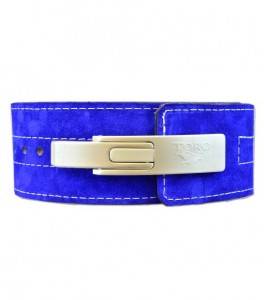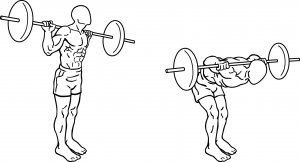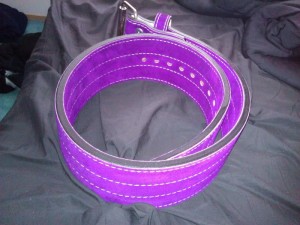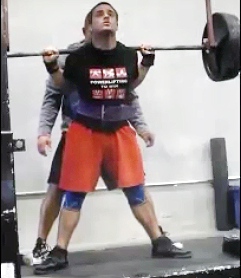Here is the big question: when should I wear a powerlifting belt in my training?
My recommended Powerlifting Belt:

If you’d rather watch than read:
Specificity
Let’s answer this question using the tools we’ve already learned throughout the Powerlifting Programming Series. In particular, we’re going to focus on specificity. The law of specificity states that you are going to get what you train for. We could have a perfect program in terms of fatigue management, in terms of autoregulation, and in terms of using a good form of progressive overload, but if that program is for swimming, it isn’t going to make too big of a difference to our lifts, is it?
Now, specificity is a continuum. We can easily move closer along the continuum. Let’s say we had a program that was perfectly optimized for… Good Mornings! Now, good mornings with a barbell are a lot closer to squats and deadlifts than swimming is to squatting and deadlifting, right? We’re going to get a much higher rate of transference between improvements to our good morning and improvements to our competition lifts than we are if we improve our swimming abilities.
If we move even closer along the continuum, it should be very clear that a beltless squat or a beltless deadlift is going to give us even higher rate of transference to our squats and deadlifts than good mornings ever will. Beltless movements are about as close to the main competition movements as you can get in terms of exercise variations.
Here’s the rub: a beltless movement is still not as specific to a competition belted squat as a… competition belted squat. That’s right. There is nothing out there that provides a higher rate of transference than actually improving your belted squat. Why? Well, if you improve your belted squat, you improve your belted squat. The carryover is 100%. For other movements, the carryover will always be some fraction of 100%.
You MUST Own A Belt
If you’re interested in powerlifting, you must own a belt. Period. There are no exceptions. Even if you’ve been training for three days, you need to own a belt.
In competition, you’re going to use a belt. If you don’t use a belt in competition, you are sacrificing 50lbs+ to your competitors. In other words, you don’t care if you win. If you aren’t willing to invest in a piece of equipment that costs less than $100, and can add up to 5-10% to your squat and deadlift, you don’t care about winning. Get a belt now.
With specificity in mind, we know that the belted squat and deadlift are the specific competition events we are trying to improve. Our training must be structured around and focused on these particular movements.
If you don’t have a belt, please see our article on the topic of how to select a proper belt. The last thing you need to do is buy some piece of junk that is actually worse than just not having a belt at all.
Long Periods without Belts are a Bad Idea
When you are going for an 8-12 week period without using your belt, you are going a very long time without actually addressing the competition form of the movement. Your training is necessarily a bit non-specific. When specificity is lower in your training, you get a lower rate of transference to your lifts with full competition gear. You’re going to get damn good at beltless training, because that is what your practicing, but you could make even better gains by focusing more on the belt.
You need to keep in mind that certain gear, such as belts and knee wraps, literally change the mechanics of the movement. You don’t perform them quite the same way. In the case of the belt, a lifter is going to be able to lean over more without ill-effects which will allow for greater use of the posterior chain. This is due to the fact that it takes great core strength to maintain an inclined torso position and belts provide direct core support which makes the greater degree of inclination possible.
How Often to Use a Belt
In my opinion, you should never use a belt less than once per week. You never want to get too far away from the competition style movement because that is the very essence of your sport if you are a powerlifter. It would be the same as a basketball player practicing with different sized balls and never using the normal size for months at a time. It just doesn’t make any sense.
Even in the very earliest parts of the off-season, when specificity SHOULD be a bit lower, I highly recommend that you do at least one training session with a belt for both the squat and deadlift. You may have 1-2 other training sessions that occur without a belt, but make sure you keep at least one with the belt.
When to Put a Belt on During Your Workout
Now, when should a lifter put on their belt during the actual workout itself? Should you put your belt on when you’re warming up with the bar? One plate? Two plates? Three plates? Eighty percent? Ninety percent? What’s the deal?
The way that I do it, and this is by no means the “only correct way”, is I throw my belt on for my very last warm-up set and my work sets. I like to wear the belt for my last warm-up because this allows me to get used to the “feel” of the new equipment before I go onto my heaviest sets. This allows for better mental preparation and, possibly, decreases injury rates. Additionally, as long as you’re getting stronger, your beltless warmups will go up over time meaning you increase your beltless strength as well. Of course, I only wear a belt if my program calls for a belt on that training session.
Now here’s the reason why I do this. If you say, I’m going only going to put on a belt above x%, you’re failing to account for the fact that belted squats and beltless squats are literally two different movements with two different maxes. The percentages are not even equivalent.
It is the same as saying I’m going to do only box squats until I’m over 80%. This just doesn’t make any sense because you’re working with two different movements that have two different maxes. If you employ this strategy, you’re not actually working at 80% of your squat, you’re probably working at 85-90% of your beltless squat. This is completely different in terms of training effect.
Final Recommendations
-
- Every Powerlifter Should Own a Powerlifting Belt
If you don’t have a belt, get one immediately. A belt is the single most important piece of powerlifting equipment in terms of being competitive. It isn’t even close. No other piece of equipment will add more to your lifts. You must have a belt even from Day 1. Yes, even complete novices should get a belt. It should be the first piece of equipment that you buy.
-
- Do at least one belted workout per week
Even if you are deep into the off-season, you should (almost) never have less than one belted session per week. There are almost no circumstances I can think of that would call for this. Remember, the competition style movements ARE your sport as a powerlifter. Would a quarterback ever go months without throwing a normal football using his normal throwing mechanics? No. So you shouldn’t go months without lifting a bar with your competition style either.
-
- Put your belt on for your last warm-up and your work sets
With this method, you give yourself one set to get “used to” the belt before you go into your heavy work sets. Additionally, as long as you get stronger, your warm-ups will get heavier over time and you will simultaneously increase your belted and beltless squat. Don’t use strategies that call for a belt over X%. Remember, belted squats and beltless squats are literally TWO DIFFERENT MOVEMENTS! You wouldn’t only bench with your normal grip above 90%, so don’t use that logic with belts either.
If you want a more thorough, comprehensive take on powerlifting belts themselves rather than just when to wear them:
http://www.powerliftingtowin.com/powerlifting-belts
Like this Article? Subscribe to our Newsletter!
If you liked this articled, and you want instant updates whenever we put out new content, including exclusive subscriber articles and videos, sign up to our Newsletter!
Questions? Comments?
For all business and personal coaching services related inqueries, please contact me:


